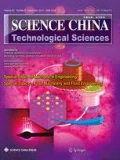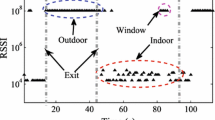Abstract
Map matching has been widely investigated in indoor pedestrian navigation to improve positioning accuracy and robustness. This paper proposes an accurate map matching algorithm based on activity detection and crowdsourced Wi-Fi (AiFiMatch). Firstly, by taking indoor road segments between activity-related locations as nodes, and the activity type from one road segment to another as directed edge, the indoor floor plan is abstracted as a directed graph. Secondly, the smartphone’s motion sensors are utilized to detect different activities based on a decision tree and then the pedestrian’s walking trajectory is divided into subtrajectory sequence according to location-related activities. Finally, the sub-trajectory sequence is matched to the directed graph of indoor floor plan to position the pedestrian by using a Hidden Markov Model (HMM). Simultaneously, Wi-Fi fingerprints are bound to road segments based on timestamp. Through crowdsourcing, a radio map of indoor road segments is constructed. The radio map in turn inversely promotes the HMM based map matching algorithm. AiFiMatch is evaluated by the experiments using smartphones in a teaching building. Experimental results show that the pedestrian can be accurately tracked even without knowing the starting position and AiFiMatch is robust to a certain degree of step length and heading direction errors.
Similar content being viewed by others
References
Wu J, Wang J, Wang L, et al. Dynamics and control of a planar 3-DOF parallel manipulator with actuation redundancy. Mechanism Machine Theor, 2009, 44: 835–849
Wu J, Yu G, Gao Y, et al. Mechatronics modeling and vibration analysis of a 2-DOF parallel manipulator in a 5-DOF hybrid machine tool. Mechanism Machine Theor, 2018, 121: 430–445
Zampella F, Jimenez Ruiz A R, Seco Granja F. Indoor positioning using efficient map matching, RSS measurements, and an improved motion model. IEEE Trans Veh Technol, 2015, 64: 1304–1317.
Bahl P, Padmanabhan V N, Balachandran A. Enhancements to the RADAR user location and tracking system. Technical Report No. MSR-TR-2000-12. Redmond, WA: Microsoft Corporation, 2000. 775–784
Fontana R J, Gunderson S J. Ultra-wideband precision asset location system. In: Proceedings of the 2002 IEEE Conference on Ultra Wideband Systems and Technologies. Baltimore, MD: IEEE, 2002. 147–150
Ni L M, Liu Y, Lau Y C, et al. LANDMARC: Indoor location sensing using active RFID. Wireless Networks, 2004, 10: 701–710
Zafari F, Papapanagiotou I. Enhancing ibeacon based micro-location with particle filtering. In: 2015 IEEE Global Communications Conference (GLOBECOM). San Diego, CA: IEEE, 2015. 1–7
Wu J, Wang D, Wang L. A control strategy of a two degrees-offreedom heavy duty parallel manipulator. J Dyn Sys Meas Control, 2015, 137: 061007.
Fu N, Zhang J, Yu W, et al. Crowdsourcing-based wifi fingerprint update for indoor localization. In: Proceedings of the ACM Turing 50th Celebration Conference-China. Shanghai, China, 2017. 34
Alaoui F T, Renaudin V, Betaille D. Points of interest detection for map-aided PDR in combined outdoor-indoor spaces. In: Proceedings of the 2017 International Conference on Indoor Positioning and Indoor Navigation (IPIN). Sapporo: IEEE, 2017. 1–8
Zhou B, Li Q, Mao Q, et al. Activity sequence-based indoor pedestrian localization using smartphones. IEEE Trans Human-Mach Syst, 2015, 45: 562–574
Aly H, Youssef M. semMatch: Road semantics-based accurate map matching for challenging positioning data. In: Proceedings of the 23rd SIGSPATIAL International Conference on Advances in Geographic Information Systems. Seattle, Washington, 2015. 5
Zhou B, Li Q, Mao Q, et al. ALIMC: Activity landmark-based indoor mapping via crowdsourcing. IEEE Trans Intell Transp Syst, 2015, 16: 2774–2785.
Abdelnasser H, Mohamed R, Elgohary A, et al. SemanticSLAM: Using environment landmarks for unsupervised indoor localization. IEEE Trans Mobile Comput, 2016, 15: 1770–1782.
Qiu C, Mutka M W. iframe: Dynamic indoor map construction through automatic mobile sensing. Pervasive Mobile Computing, 2017, 38: 346–362
Wang B, Chen Q, Yang L T, et al. Indoor smartphone localization via fingerprint crowdsourcing: Challenges and approaches. IEEE Wireless Commun, 2016, 23: 82–89
Zhang X, Yang Z, Wu C, et al. Robust trajectory estimation for crowdsourcing-based mobile applications. IEEE Trans Parallel Distrib Syst, 2014, 25: 1876–1885.
Xiang L, Tai T Y, Li B, et al. Tack: Learning towards contextual and ephemeral indoor localization with crowdsourcing. IEEE J Sel Areas Commun, 2017, 35: 863–879
Newson P, Krumm J. Hidden Markov map matching through noise and sparseness. In: Proceedings of the 17th ACM SIGSPATIAL international conference on advances in geographic information systems. Seattle, Washington, 2009. 336–343
Seitz J, Jahn J, Boronat J G, et al. A hidden markov model for urban navigation based on fingerprinting and pedestrian dead reckoning. In: 2010 13th Conference on Information Fusion (FUSION). Edinburgh, UK: IEEE, 2010. 1–8
Woodman O, Harle R. Pedestrian localisation for indoor environments. In: Proceedings of the 10th International Conference on Ubiquitous Computing. Seoul, 2008. 114–123
Author information
Authors and Affiliations
Corresponding author
Additional information
This work was supported by the National Natural Science Foundation of China (Grant No. 61702288), the Natural Science Foundation of Tianjin in China (Grant No. 16JCQNJC00700) and the Fundamental Research Funds for the Central Universities.
Rights and permissions
About this article
Cite this article
Yu, W., Zhang, J., Xu, J. et al. An accurate indoor map matching algorithm based on activity detection and crowdsourced Wi-Fi. Sci. China Technol. Sci. 62, 1492–1501 (2019). https://doi.org/10.1007/s11431-018-9346-3
Received:
Accepted:
Published:
Issue Date:
DOI: https://doi.org/10.1007/s11431-018-9346-3




